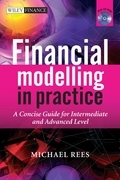
Financial modelling in practice: a concise guide for intermediate and advanced level
Rees, Michael
How do you estimate the value of a security when its future trajectory, or the trajectory of the other securities or economic variables it depends on, is unknown? Based on the authors many years of real-life solutions to financial modeling, Financial Modelling in Practice teaches readers how to build and operate a range of financial models. This practical, in-depth guide provides an in-depth look at financial modeling and covers the full range of topics that are truly relevant to financial engineers, academics, and students in financial modeling. INDICE: Contents Background, Objectives and Approach About The Author Acknowledgements 1 Building Blocks: Selected Excel Functions and Tools Core Functions for Financial Modelling Arithmetic Operations Logical Operations FinancialCalculations Database Functions, Features and Pivot Tables Statistical Functions Lookup and Reference Functions Text Functions Information Functions Array Functions, Formulae and Matrix Calculations GoalSeek and Solver The Analysis ToolPak and Other Add-ins Selected Excel Short-cuts 2 Principles of Modelling What is a Good Model? Model Design Selection of Model Variables and their Dependencies Level of Detail or Aggregation Model Structure and Planning Logical Flow Compactness Named Ranges Circular References Model Building Formatting and Comments Creating Robust Formulae Results Presentation and Other Uses of Sensitivity Analysis General Remarks on Presentation Using Data Tables to Conduct Sensitivity Analysis Hiding and Protecting Models Model Auditing 3 Financial Statement, Cash Flow and Valuation Modelling Financial Statement Modelling: CorePoints and Example General Comments Income Statement Forecasting Balance Sheet Forecasting Cash Flow Statement Forecasting Error Checks and Feasibility Checks General Error Checking Tools Feasibility Checking and Ratio Analysis Adding Generality Cash Flow Valuation Calculation of Free Cash Flow Discounting Free Cash Flow Terminal Value Calculations Further Adjustments Sensitivity Analysis 4 Risk Modelling Benefits and Challenges of Risk Modelling The Risk Modelling Process An Introduction to Simulation Techniques The Language of Probability Distributions Quick Guide to using RISK Types of Dependency Relationships inRisk Models The Selection and Use of Distributions Pragmatic Approaches and Distributions Data-Driven Approaches and Distributions Scientific Approaches and Distributions: The Basics Further Aspects of the Science of Distributions Further Example Models 5 Introduction to Options and Real Options Modelling Financial Market Derivatives: An Introduction Real Options Modelling Uses and Relationships to Other Types of Analysis Examples using Simulation Examples using Trees 6 VBA for Financial Modelling Introduction The Bare Essentials Simple Examples Building Blocks Working with Ranges Writing Robust Code Further Topics Object Orientation: An Introduction Controlling Execution and Related Topics Working with Functions Checking and Debugging Code Examples: Recording Macros and Related Topics Introduction Using GoalSeek and Solver Examples: Simulation Modelling Introduction Examples: User-defined Functions Creating Functions Examples Structure and Organisation: Further Topics Further Reading Index
- ISBN: 978-0-470-99744-4
- Editorial: John Wiley & Sons
- Encuadernacion: Cartoné
- Páginas: 296
- Fecha Publicación: 24/10/2008
- Nº Volúmenes: 1
- Idioma: Inglés
